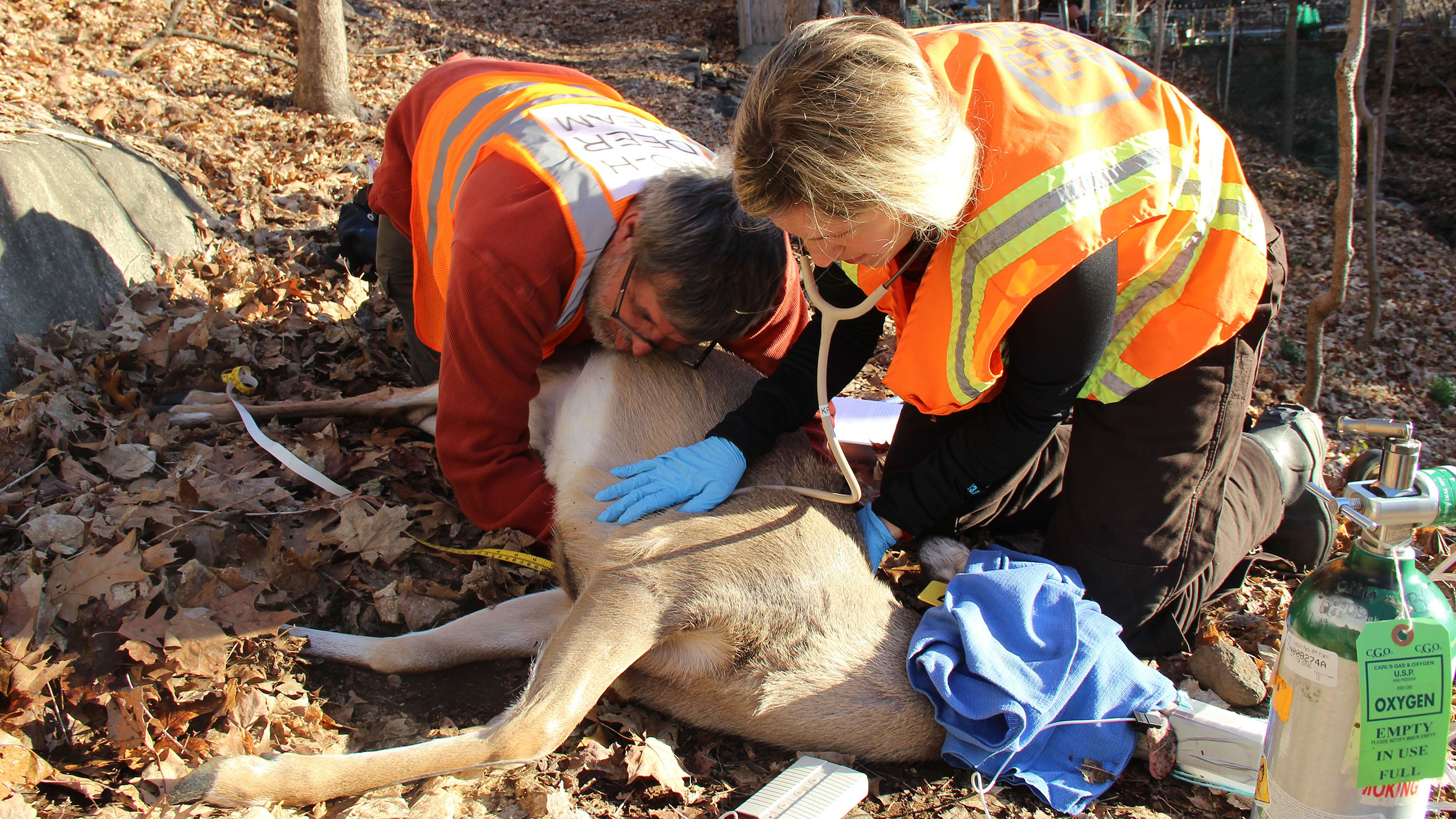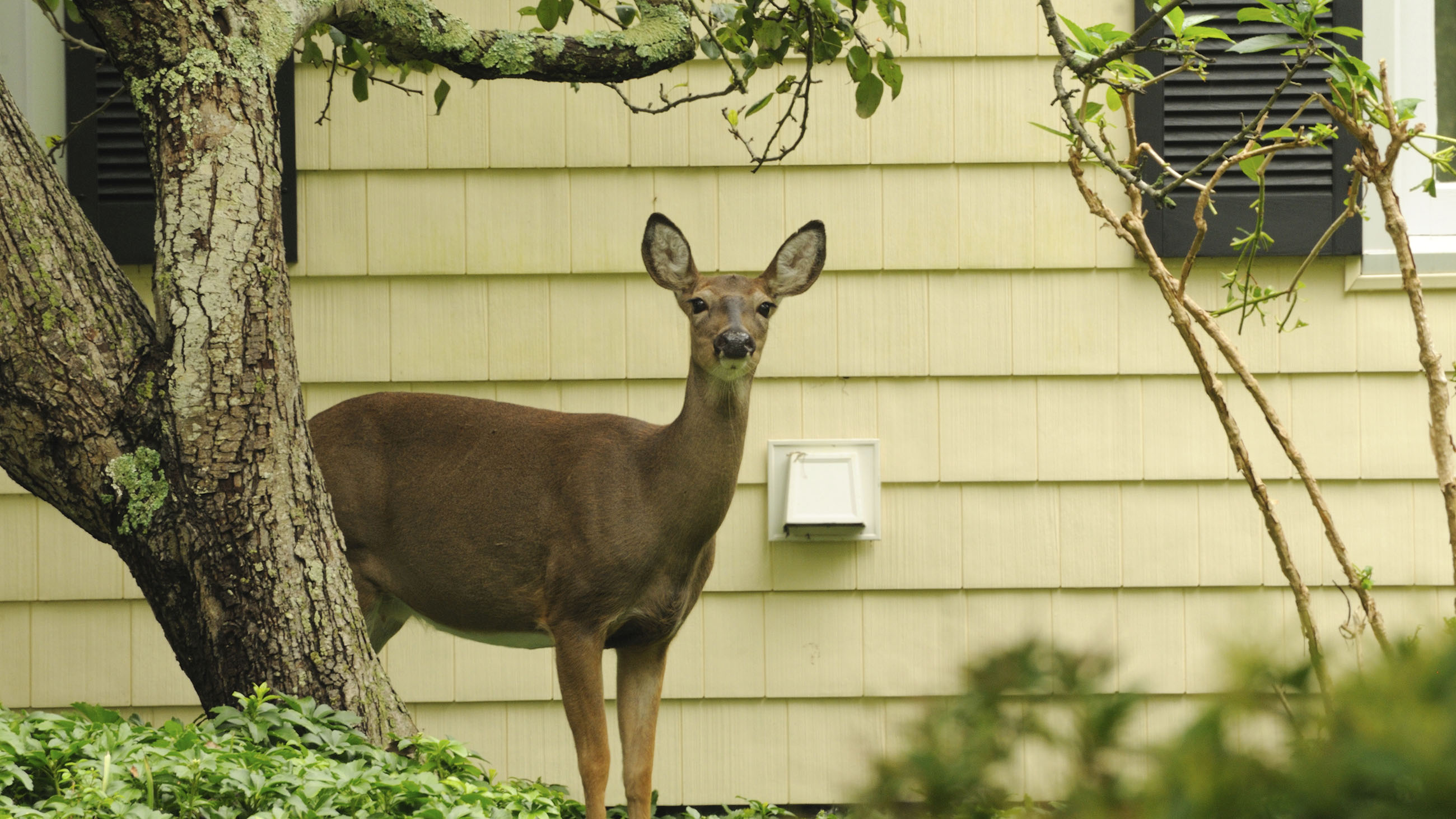In Suburban New York, Biologists Explore Birth Control for Bambi
At daybreak on a golden March morning in Hastings-on-Hudson, New York, a bearded man named Dave Pauli hunches in the backseat of a Toyota 4Runner, scanning the somnolent streets for white-tailed deer. An air-powered Dan-Inject dart gun rests across his lap, its slender barrel poking out the window. Kali Pereira, the SUV’s driver and, like Pauli, a wildlife biologist with the Humane Society of the United States, edges up to a small herd ambling across the manicured lawn of a white split-level. The deer — a buck, a doe, and two year-old fawns — crane their necks to regard the creeping vehicle.
“Stop stop stop,” Pauli whispers. He hoists the gun, squints, and squeezes the trigger. A steel dart hisses through the air and, with a muffled thump, embeds itself in the haunches of the startled doe. The deer scatter and the doe’s tail flashes as she bounds over a boulder and disappears.
Pereira checks her watch: 6:46 a.m. “The element of chase is something we like to eliminate,” she says. “Once their adrenaline gets pumping, they’ll just burn off the drugs.”
In addition to its cocktail of sedatives, the dart also contains a radio transmitter for easy tracking. Pauli and Pereira find the unconscious doe fifteen minutes later, collapsed on a bed of dry leaves between houses. Suburban debris — a discarded soccer ball, a plastic baseball bat — litter the glade. Pereira, a willowy scientist in smudged overalls, covers the doe’s head with a cloth, inserts an oxygen tube into her mouth, and presses a stethoscope against the animal’s chest. “She’s in excellent condition,” the biologist whispers. The deer smells faintly musty, like the inside of a stable.
Working swiftly, Pereira clips a palm-sized yellow tag, stamped with the number 41, onto the doe’s right ear. Pauli carefully removes the dart and cleans the small wound it has gouged in 41’s hindquarters, then draws a blood sample, causing the doe to kick fitfully. Finally, it’s time for the pièce de résistance: A long needle containing a milky emulsion, which Pauli plunges into the deer’s tawny flank. This is the PZP — or porcine zona pellucida — a birth control vaccine and the latest front in one of the United States’ most vexing wildlife conflicts.


The proliferation of white-tailed deer in suburban backyards is a paradox: part conservation success story, part environmental catastrophe. Over the past century, humans have created prime conditions for Odocoileus virginianus. We’ve wiped out their predators, enhanced their numbers for hunters, and planted trees and gardens on which they love to feed. With a population once as low as 500,000, the number of white-tailed deer in the United States is now more than 20 million. In many places, more deer roam today than when Europeans arrived on the continent.
The unchecked abundance has produced ecological chaos. Deer, and their voracious browsing, hinder the growth of young trees, aid the spread of invasive plants, and destroy habitat for songbirds and other woodland creatures. According to some ecologists, deer may be the worst threat facing eastern forests — more destructive, even, than climate change. And the danger isn’t limited to black oaks and blue jays. Collision between cars and deer inflict billions of dollars in vehicular damage and kill more than 100 drivers annually. Deer also host black-legged ticks, the arachnids that transmit Lyme disease. As Aldo Leopold, ecology’s patron saint, wrote in 1949: “(J)ust as a deer herd lives in mortal fear of its wolves, so does a mountain live in mortal fear of its deer.” Replace mountain with subdivision, and Leopold looks even more prophetic.
Hastings-on-Hudson, a Westchester County village 15 miles north of New York City, is no stranger to these perils. The town averages more than 100 cases of Lyme, 20 deer-related car accidents, and a half-million dollars in vegetation damage each year. Other afflicted suburbs, from the Washington, D.C., area to St. Louis, have thinned their herds with bows, shotguns and rifles. But in Hastings, a liberal community where Priuses outnumber guns by an order of magnitude, the prospect of killing Bambi was repugnant. When the town briefly proposed culling deer through a so-called “net and bolt” program, Mayor Peter Swiderski drew comparisons to Hitler. “Culturally and practically, a lethal program in Hastings would have been too much grief,” Swiderski said.
In 2009, a local animal protection group pointed Swiderski to Allen Rutberg, director of Tufts University’s Center for Animals and Public Policy. Rutberg is an expert in the use of PZP, which has been deployed on ungulates from elephants to horses. The vaccine, which is developed from pigs, triggers the immune system to produce antibodies that distort the sperm receptors that surround eggs. If each sperm is a key, PZP changes the shape of the lock.
Compared to other population control techniques, like surgically removing deer’s ovaries — the method of choice in New York towns such as Cayuga Heights — PZP confers some crucial advantages. The vaccine is cheaper, less invasive, and, because it requires a booster shot to maintain its effectiveness, reversible. Want more deer after all? Just stop giving boosters. In a series of pilot projects in the 1990s and 2000s, Rutberg tested PZP at sites in South Carolina, New York, Maryland and Connecticut with promising results. On South Carolina’s Fripp Island, PZP cut deer density in half. “In situations when you don’t have much movement on or off site, we’ve shown that you can have a pretty dramatic effect,” Rutberg said.
But Hastings represented a new challenge — a truly “open system.” In Hastings, unlike on the confines of Fripp Island, unvaccinated does could simply wander over from adjacent towns. “Female deer show a lot of site fidelity; about 90 percent stay put,” Rutberg said. “But they can still move in from other areas. The question is, do they?”
And it’s not just the females that Hastings needs to worry about. Starting in 2007, researchers at Cornell performed 77 tubal ligations — a procedure commonly known as “getting your tubes tied” — on the deer overrunning the university’s grounds. Six years later, though, the population hadn’t budged. According to Paul Curtis, the project’s leader, that’s because female deer that have undergone tubal ligation still have normal hormonal cycles, including the stage of reproductive readiness known as being “in heat.” Under normal conditions, most female deer are pregnant by late fall. But because Cornell’s tube-tied deer couldn’t get knocked up, their cycles continued into March — projecting come-hither chemicals that lured every male within sniffing distance onto the Cornell campus. “The immigration of bucks negated everything we did in terms of reduced fawn production,” Curtis said. “It was a total wash.”
Because immunocontraception, like tubal ligation, doesn’t prevent female deer from entering heat, Curtis is skeptical that PZP will work in open systems like Hastings. Instead, he recommends ovariectomies, which shut down hormonal cycles altogether. In the end, Cornell has resorted to standard lethal tactics, recruiting volunteer archers to shoot the deer. Curtis said the strategy has slashed the campus’ population in half. “That’s the only thing that’s really worked,” he said.
According to Rutberg, horny males don’t appear to be flooding into Hastings — at least not yet. Cornell’s example, he said, is “a sample size of one.” Still, the village’s permeable borders have everyone anxious. “If you wanted to reduce this project to one sentence,” said Swiderski, the mayor, “it would be this: Can we deplete the deer’s numbers faster than immigration can replace them?”

Wildlife management is often a euphemism for killing, and the most successful creatures are typically the ones under fire. We’ve created prime conditions for clever generalists like coyotes, cormorants, and ravens; now we punish them en masse for having the gall to take advantage. But one person’s infernal pest is another’s biodiversity — particularly in the thoroughly developed New York suburbs, where the nearest charismatic megafauna are the inmates at the Bronx Zoo. As they drive around Hastings, Pauli and Pereira stop frequently to discuss the project with locals, most of whom seemed conflicted about their antlered neighbors. “You have no idea what we’re going through here with the garden,” a woman named Ellen tells the biologists, sounding like her home had been beset by Huns. “But it’s just so beautiful seeing all the deer together,” she adds in the next breath. “I love them.”
Although many residents harbor no such sentimentality — the phrase “rats with hooves” is not uncommon — they’ve embraced the project, perhaps out of desperation. Fluorescent flags granting biologists permission to treat deer on private property flutter on neighborhood lawns. Some homeowners have let Pauli use their garages and porches as makeshift hunting blinds. High school students are studying tree diversity in town woodlands to see whether saplings will bounce back during the experiment. “This project takes community effort as much as it takes our fieldwork,” Pereira said.
The deer have not proved equally cooperative. White-tails are wily by nature, and they turn understandably skittish around gun-packing strangers; many also linger near schools, where the team can’t dart. After three years, the biologists have vaccinated a total of 48 deer, likely a bit less than half the population; this fall, they’ll return to Hastings to administer booster shots to the does treated in 2014, identifiable by their numbered ear-tags. If future camera trap studies reveal that the population is indeed falling, and if vaccination can be cheaply scaled up, the village might adopt PZP on a more permanent basis. For now, though, it remains more experiment than cure, to the confusion of locals who expect a quick fix. “Camera traps are the gold standard that will ultimately get us our signal,” said Swiderski, who’s received inquiries from curious towns in a half-dozen states, including Ohio, Georgia, and Texas, since the project began. “But that will take a while — probably more than five years.’
In the meantime, deer #41 was as obliging a patient as a biologist could ask for. After administering the PZP, Pereira gave the deer an injection to reverse the effects of the sedative; soon the animal was scrambling groggily to her feet, like a newborn learning to walk. “Sometimes there’s this feeling like, ‘Aw man, we’re taking motherhood away from them,’” Pereira whispered as the doe trotted off. “But she’ll stay a mom — she just won’t have any baby kids.”
Added Pauli: “She’ll be the best auntie in the world.”
Ben Goldfarb is an environmental journalist whose writing has appeared in Mother Jones, Science, The Guardian, Orion Magazine, Outside, Audubon Magazine, Scientific American, and many other publications.










